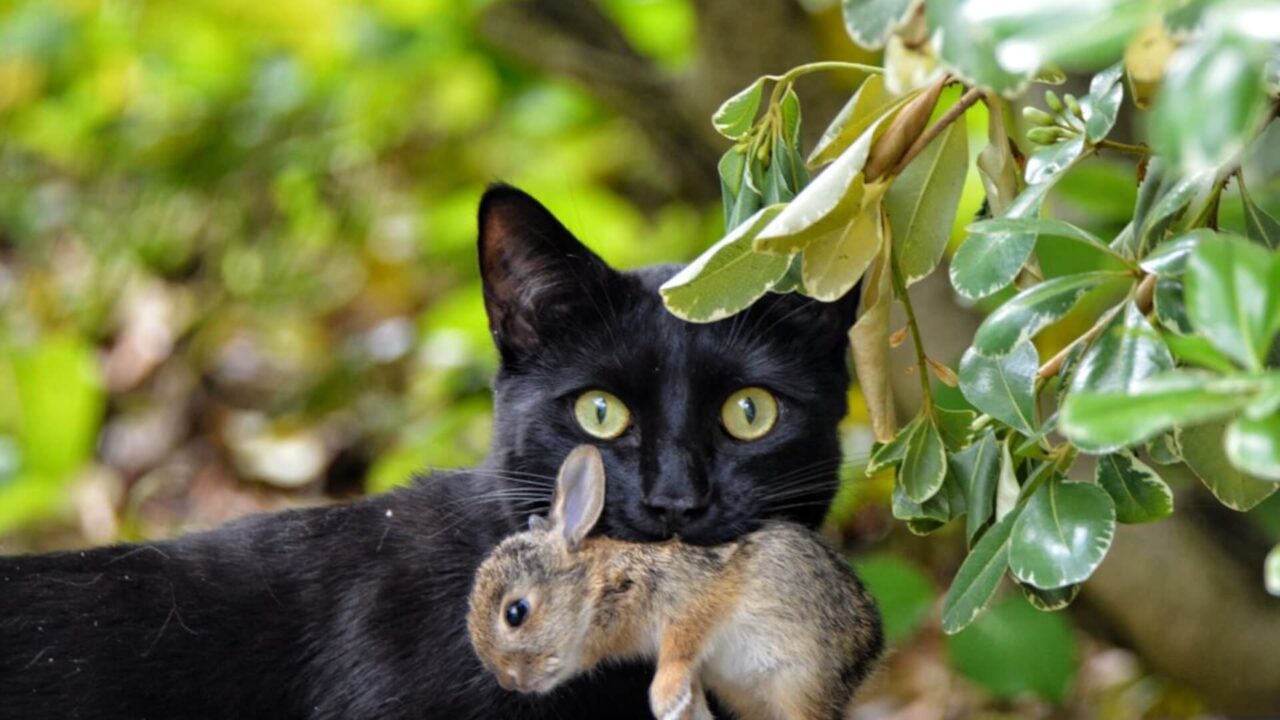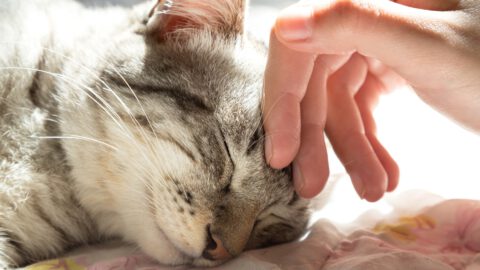Last Updated on July 25, 2021
Cats are known for finding places wildlife likes to hide. They are considered to be some of the best hunters in the world for a reason, be it a large tiger or a small house cat. For the latter, issues can arise if you allow your cat to free roam the neighborhood. While we always encourage cat owners to keep their cats indoors for safety reasons, we understand that some people still enjoy allowing their cat to have their freedom. With freedom comes great responsibility and we hate to break it to you, but Mr. Mittens is a registered assassin! Cats will hunt and kill for fun, no joke. So what happens if your outdoor cat finds a rabbit’s nest with wild bunnies inside? We will go through the options below to help you the best we can!
Option One: Let Nature Run Its Course
Once a cat finds a rabbit’s nest, they are very unlikely to leave it alone. This means even if you put the babies back and fix the nest, if you allow your cat to go out again they will go right back to it. The scent of the cat being around may already discourage the mother from entering the location. Moving the bunnies to a new location may also inhibit the mother from finding them to nurse and the babies will eventually die of starvation. So you can let your cat be a cat or try moving the bunnies and hope the mother is able to find them.
Option Two: Contact A Local Wildlife Rescue
For many locations, there are rescue centers and facilities that directly help treat, care for, and release wild animals. Their objective would be to raise the wild bunnies in place of the mother and release them to the wild once they are fully weaned. While it is very difficult to raise baby bunnies without the mother’s help, it is not impossible. Experts in the field are likely to have a higher rate of success than someone with no experience. Contacting a wildlife rescue in your area and having them come pick up the bunnies might be your best option.
Option Three: Take In The Babies To Raise Yourself
When option two just isn’t an option and you can’t bear the thought of them not making it, you can take them in to raise yourself. You will first want to make the nesting area is cat-proof and keep your cat away to encourage the mother to come back. Mother rabbits feed their babies twice a day, once in the early morning and one at night. She does not remain at the nest very long during feedings as she wants to keep her scent away from the babies. If you notice that she is not returning and the babies are becoming thinner, then taking them into care is the best bet for survival. Details on how to raise and release wild baby bunnies are below.
We strongly encourage finding an expert to care for the bunnies in place of their mother. Our advice is not expert-level advice, just what has worked for bunnies we have cared for.
Never Punish Your Cat
If your cat has found a nest and has possibly injured or killed some baby rabbits, never punish them for this behavior. It is part of their instinctual nature. They are hunters and even with an ample diet at home, they will still want to hunt and play with wild creatures. House cats are not fully domesticated, they are semi-domesticated at best so punishing them for something they will not understand will only hurt your relationship with your cat. They are very unlikely to listen anyways!
Keeping Your Cat Indoors Will Prevent This
As mentioned, we always encourage cat owners to not let their cats free-roam outside. When you keep them indoors, you prevent them from disturbing nests in the wild. As tempting as it is (because you know how much they would enjoy it) the risks outweigh the benefits. Cats are susceptible to catching many illnesses and diseases as well as parasitic infections when they are let out to free roam. You also have to consider the chances of them getting into poison, being hit by a car, or being abused by a person. If you want a safer option for your cat while still allowing them to have fresh air outdoors, you can either leash train your cat or invest in an outdoor enclosure. Both are great ways of allowing your cat outside to enjoy nature while protecting them and wildlife at the same time.
How To Care For Wild Baby Bunnies
It is more than likely that your cat has found a cottontail nest. This is the most common species of wild rabbit within the US. Getting a general idea of the age is a good start. Having little to no fur means they are less than 3 days old. Around 5 days they will have a full coat of fine fur. If the eyes are still closed they are under 10 days old. Cottontail babies open their eyes between 10 days and 2 weeks of age. If you found a nest, they are likely to be under 2 weeks old as once their eyes open, they begin to leave the nest to eat weeds and grass but remain close to it for when their mother comes back for feedings.
What You Will Need To Buy:
- Goat’s Milk Esbilac Powder OR KMR Kitten Milk Replacer Powder
- Bene-Bac Pet Gel (probiotics)
- A small syringe with feeder nipple or dropper (we recommend a glass dropper)
- A heating pad
Building A Nest
You will want to keep the babies in a warm, quiet space. Using a heating pad is a great way to ensure they stay warm. You will want to use a heating pad until they are around 3 or 4 weeks old. Never place the babies directly on the pad as they can burn. Always keep it on low heat and beneath towels or a small blanket. You can use a cardboard box, critter keeper, glass aquarium, or dog/cat crate to keep them in. Just ensure whatever you keep them in, they can’t get out and have enough air getting in. We use small towels for the bedding and fleece winter gloves to allow them to burrow under.
Feeding
You will have to do two feedings per day of the milk of your choice. We recommend goat’s milk as we feel it is better to have bunnies on vegetarian-based milk and it tends to be cheaper. The amount you do at each feeding will depend on the age. You will want to add warm, clean (preferable not tap) water and ensure it stays warm. You can use the microwave to warm up the water and then keep the milk in a floating container on top during feeding. Follow the instructions on the can for mixing measurements and make it slightly thicker than cow’s milk. Always make sure the milk is not hot. Baby rabbits should look plump in the belly after each feeding. Watch the video below to see how it’s done!
Newborns to 1 week of age will drink about 4-5 cc of formula per feeding.
From there:
1 to 2 weeks old: 10-15 cc per feeding
2 to 3 weeks old: 15-30 cc per feeding
3 to 6 weeks old: 30 cc per feeding
Assisted Urination/Defecation Is Needed
If the bunnies still have their eyes closed, you will need to assist them with urination and defecation after each feeding. This can be done by rubbing their private parts with a damp cloth, wet cotton ball, or your bare hand with a bit of water. They should urinate within a few minutes of doing this. The reason this needs to be done is that the mother rabbit assists them in the wild. If they have urine in them too long, it can lead to death. You will need to do this until you notice them urinating on their own (usually around 7 to 10 days old).
Probiotics
You will need to use the Bene-Bac probiotic gel every other day for the first week which is about one tube’s worth. This will ensure they have a healthy and strong digestive system and proper immunity. You only need a small amount per feeding. We recommend doing another week after one week off it.
Introducing A Wild Diet
When the baby bunnies have opened their eyes, it is now time to introduce their wild diet. What we have done was gather different varieties of grass, weeds, flowers, and other leafy greens from the yard. There is no need to wash them after they have had at least one round of probiotics. You have to be 100% certain no pesticides are used on or around where you gather the food. If you happen to have any kind of small wild berries, they will eat these as well. We feel it is best to provide a fully natural diet outside of the goat’s milk for the best bet of survival. Some favorites cottontails enjoy eating include dandelions, white clovers, wild lettuce, creeping buttercups, daisies, wild wheat, crabgrass, and chickweed.
When To Release Baby Bunnies
At 6 weeks old, the bunnies can be released into the wild! If you feel they are a bit underweight, you can continue feeding milk for an additional one or two weeks but they must be released no later than 8 weeks old as it hurts their chances of survival in the wild. A favorite spot for bunnies and rabbits alike is a heavily wooded area alongside an open field. This offers them a wide variety of food as well as protection and shelter just a few hops away. It is best to find a spot that is quiet and away from heavily trafficked places. Be sure your cat as well as other cats are not in the area when you are releasing the babies.
It is a good idea to do pre-release protected days first if you can. What this means is you keep them outside in a protected area away from predators to allow them to get used to the environment and allow them to build up a natural fear for things larger than them. Make sure you are bringing them food twice a day and they have access to water and a cool spot if the temperatures are hot or a warm spot if the temperatures are cold. You will want to do this for a minimum of 3 days. Make sure you do not have them contained, even outdoors, beyond 8 weeks of age.
Questions & Concerns
If you have any questions or concerns dealing with rabbits, wild cottontails, and raising wild bunnies we strongly encourage you to get in touch with a wildlife rescue that has skilled experience in handling care, treatment, and release programs for wild animals. Again, we are not wildlife experts.
Thanks to Smithsonian for the great featured image.




